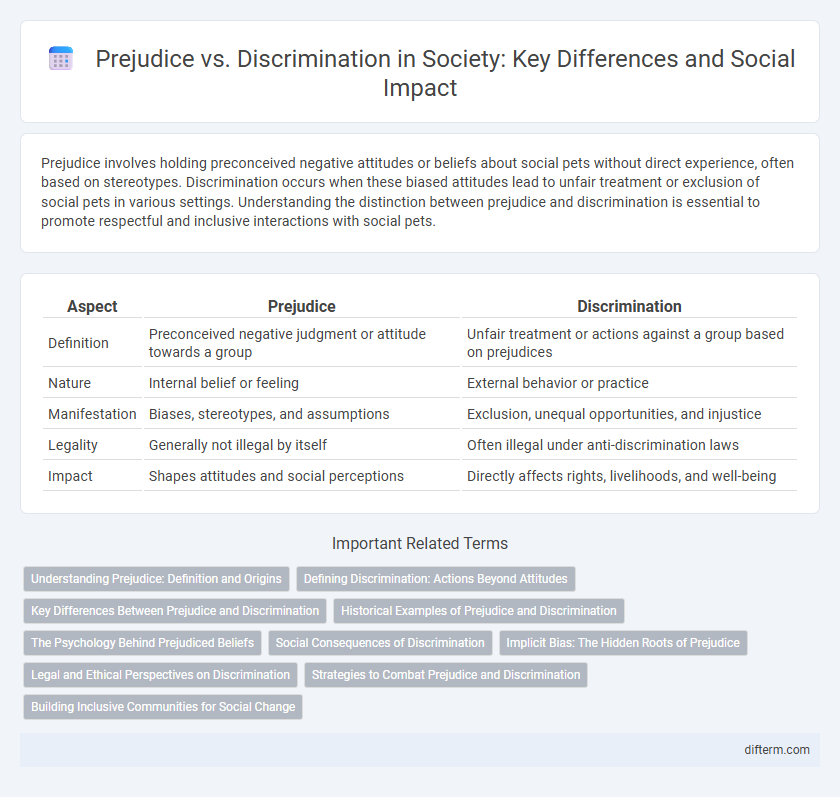Prejudice involves holding preconceived negative attitudes or beliefs about social pets without direct experience, often based on stereotypes. Discrimination occurs when these biased attitudes lead to unfair treatment or exclusion of social pets in various settings. Understanding the distinction between prejudice and discrimination is essential to promote respectful and inclusive interactions with social pets.
Table of Comparison
| Aspect | Prejudice | Discrimination |
|---|---|---|
| Definition | Preconceived negative judgment or attitude towards a group | Unfair treatment or actions against a group based on prejudices |
| Nature | Internal belief or feeling | External behavior or practice |
| Manifestation | Biases, stereotypes, and assumptions | Exclusion, unequal opportunities, and injustice |
| Legality | Generally not illegal by itself | Often illegal under anti-discrimination laws |
| Impact | Shapes attitudes and social perceptions | Directly affects rights, livelihoods, and well-being |
Understanding Prejudice: Definition and Origins
Prejudice refers to preconceived opinions or attitudes about a group based on stereotypes rather than direct experience or knowledge. It originates from socialization processes, cultural influences, and cognitive biases that categorize individuals into in-groups and out-groups. Understanding prejudice involves examining its psychological roots, such as fear of the unknown, and social factors like systemic inequalities that perpetuate biased thinking.
Defining Discrimination: Actions Beyond Attitudes
Discrimination involves actions or behaviors that treat individuals or groups unfairly based on characteristics such as race, gender, or religion, going beyond mere prejudiced attitudes. It manifests in practices like exclusion from jobs, unequal treatment in education, or biased law enforcement, directly impacting opportunities and rights. Understanding discrimination as conduct rather than belief emphasizes the social and legal responsibilities to challenge and prevent injustices in various institutions.
Key Differences Between Prejudice and Discrimination
Prejudice is a preconceived opinion or attitude towards a group or individual, often based on stereotypes and lacking factual evidence. Discrimination involves actions or behaviors that treat people unfairly or unequally based on their group membership, such as race, gender, or religion. While prejudice represents an internal bias or belief, discrimination is the external manifestation of that bias through harmful practices or policies.
Historical Examples of Prejudice and Discrimination
Historical examples of prejudice and discrimination include the segregation laws of Jim Crow in the United States, which institutionalized racial discrimination against African Americans from the late 19th century through the 1960s. The Holocaust during World War II exemplifies extreme ethnic prejudice and systemic genocide against Jews and other marginalized groups under Nazi Germany. Apartheid in South Africa legally enforced racial segregation and inequality from 1948 to the early 1990s, highlighting the impact of state-sanctioned discrimination on social structures.
The Psychology Behind Prejudiced Beliefs
Prejudiced beliefs stem from cognitive biases and social categorization processes that simplify complex social environments by grouping individuals into in-groups and out-groups. These mental shortcuts often lead to stereotyping and emotional responses such as fear or mistrust, which reinforce negative attitudes toward certain social groups. Understanding the psychological mechanisms, including confirmation bias and social identity theory, is crucial to addressing the root causes of prejudice and reducing discriminatory behaviors.
Social Consequences of Discrimination
Discrimination leads to social fragmentation by fostering mistrust and alienation among marginalized groups, which undermines community cohesion and civic participation. It perpetuates economic inequality and restricts access to education and employment opportunities, exacerbating social stratification. The resulting social exclusion increases vulnerability to mental health issues and diminishes overall societal well-being.
Implicit Bias: The Hidden Roots of Prejudice
Implicit bias refers to unconscious attitudes or stereotypes that influence individuals' perceptions and actions toward others, often without intentional awareness. These hidden biases contribute significantly to prejudice by shaping negative assumptions and judgments based on race, gender, or other social categories. Understanding implicit bias is crucial for addressing the subtle yet pervasive roots of discrimination in social interactions and institutional practices.
Legal and Ethical Perspectives on Discrimination
Discrimination involves actions or policies that disadvantage individuals based on characteristics such as race, gender, or religion, often codified in laws to protect civil rights and ensure equality. Legal frameworks like the Civil Rights Act and anti-discrimination statutes criminalize discriminatory behaviors and provide remedies for victims. Ethical perspectives emphasize the moral obligation to treat all individuals with dignity and fairness, promoting social justice and inclusivity in both public and private spheres.
Strategies to Combat Prejudice and Discrimination
Effective strategies to combat prejudice and discrimination include promoting education about diversity and inclusion, which helps challenge stereotypes and fosters empathy. Implementing anti-discrimination policies within workplaces and schools creates safe environments and ensures accountability for biased behavior. Community programs that encourage intercultural dialogue and collaboration can also reduce social divides and build mutual respect among diverse groups.
Building Inclusive Communities for Social Change
Prejudice refers to preconceived negative attitudes towards individuals based on group identity, while discrimination involves actions that unfairly treat people differently due to those biases. Building inclusive communities requires addressing both prejudice and systemic discrimination by promoting empathy, equity, and accessible opportunities. Effective social change emerges when diverse voices are empowered, policies are reformed, and inclusive practices become community norms.
prejudice vs discrimination Infographic

 difterm.com
difterm.com